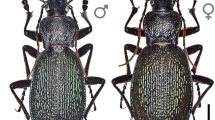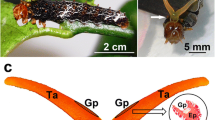Abstract
The phylogenetically primitive rove beetleDeleaster dichrous (Grav.) (Oxytelinae) has been shown for the first time to possess two pairs of neighboring abdominal glands which are depleted simultaneously on molestation. The morphology of these glands is described. The defensive constituents of theDeleaster glands were elucidated directly from the mixtures by gas chromatographic-mass spectroscopic methods and microchemical reactions. The paired whitish glands secrete iridodial, which polymerizes on exposure to air to form an adhesive that probably deters small predatory arthropods. The red gland system ofD. dichrous contains the toxicp-toluquinone and a variety of isopropyl andsec-butyl esters. Artificial quinoid ester mixtures simulating the secretion ofD. dichrous showed only weak effects on mortality ofLucilia larvae in comparison with more effective secretions of phyiogenetically derived Oxytelinae. The secretion of the primitive genusDeleaster is characterized chemotaxonomically by β, γ-unsaturated C12 acids and esters, which are postulated as precursors for the characteristic defensive compounds of the derived species, thus indicating a clear evolutionary trend at the micromolecular level.
Similar content being viewed by others
References
Aldrich, J.R., andYonke, T.R. 1975. Natural products of abdominal and metathoracic scent glands of coreid bugs.Ann. Entomol. Soc. Am. 68:955–960.
Araujo, J. 1973. Morphologie et histologie de la glande pygidiale defensive deBledius spectabilis Kr. (Staphylinidae, Oxytelinae).C.R. Acad. Sci. Ser. D. 276:2713–3716.
Araujo, J. 1978. Anatomie comparee des systemes glandulaires de defense chimique des Staphylinidae.Arch. Biol. (Bruxelles) 89:217–250.
Baker, J.T., Blake, J.D., MacLeod, J.K., Ironside, D.A., andJohnson, I.C. 1972. The volatile constituents of the scent gland reservoir of the fruit-spotting bug,Amblypelta nitida.Aust. J. Chem. 25:393–400.
Bellas, T.E., Brown, W.V. andMoore, B.P. 1974. The alkaloid Actinidine and plausible precursors in defense secretions of rove beetles.J. Insect Physiol. 20:277–280.
Blum, M.S. 1981. Chemical Defenses of Arthropods. Academic Press, New York.
Blum, M.S. andHermann, H.R. 1978. Venoms and venom apparatuses of the Formicidae: Dolichoderinae and Aneuretinae, pp. 871–894,in S. Bettini (ed.). Arthropod Venoms. Handbook of experimental Pharmacologie, vol. 48. Springer, Berlin.
Cavill, G.W.K., Ford, D.L., andLocksley, H.D. 1956. The chemistry of ants. I. Terpenoid constituents of some AustralianIridomyrmex species.Aust. J. Chem. 9:288–293.
Cavill, G.W.K., andHoughton, E. 1974. Volatile constituents of the Argentine antIridomyrmex humilis.J. Insect Physiol. 20:2049–2059.
Dettner, K. 1983. Vergleichende Untersuchungen zur Wehrchemie und Drüsenmorphologie abdominaler Abwehrdrüsen von Kurzflüglern aus dem Subtribus Philonthina (Coleoptera, Staphylinidae).Z. Naturforsch. 38c:319–328.
Dettner, K. 1984. Isopropylesters as wetting agents from the defensive secretion of the rove beetleCoprophilus striatulus F. (Coleoptera, Staphylinidae).Insect Biochem. 14:383–390.
Dettner, K. 1985. Ecological and Phylogenetic Significance of Defensive Compounds from Pygidial Glands of Hydradephaga (Coleoptera).Proc. Acad. Nat. Sci. Philadelphia. 137:156–171.
Dettner, K., andSchwinger, G. 1982. Defensive secretions of three Oxytelinae rove beetles (Coleoptera: Staphylinidae).J. Chem. Ecol. 8:1411–1420.
Eisner, T. 1970. Chemical defense against predation in arthropods, pp. 157–217,in E. Sondheimer and J.B. Simeone (eds.). Chemical Ecology. Academic Press, New York.
Franke, W., Levinson, A.R., Jen, T.-L., andLevinson, H.Z. 1979. Carbonsäure-isopropylester— eine neue Klasse von Insektenpheromonen.Angew. Chem. 91:843–844.
Happ, G.M., andHapp, C.M. 1973. Fine structure of the pygidial glands ofBledius mandibularis (Coleoptera, Staphylinidae).Tissue Cell 5(2):215–231.
Herman, L.H. 1970, Phylogeny and reclassification of the genera of the rove beetle subfamily Oxytelinae of the world (Coleoptera, Staphylinidae).Bull. Am. Mus. Nat. Hist. 142:343–454.
Hinton, H.E. 1944. Some general remarks on subsocial beetles, with notes on the biology of the staphylinid,Platystethus arenarius (Fourcr.).Proc. R. Entomol. Soc. London (A) 19:115–128.
Jefson, M., Meinwald, J., Nowicki, S., Hicks, K., andEisner, T. 1983. Chemical defense of a rove beetle (Creophilus maxillosus).J. Chem. Ecol. 9:159–180.
Moore, B.P., andBrown, W.V. 1979. Chemical composition of the defensive secretion inDyschirius Bonelli (Coleoptera: Carabidae: Scaritinae) and its taxonomic significance.J. Aust. Entomol. Soc. 18:123–125.
Myerson, J., Haddon, W.F., andSoderstrom, E.L. 1982.Sec-butyl (Z)-7-tetradecenoate. A novel sex pheromone component from the western grapeleaf skeletonizer,Harrisiana brillians.Tetrahedron Lett. 23:2757–2760.
Newton, A.F. 1982. A new genus and species of Oxytelinae from Australia, with a description of its larva, systematic position, and phylogenetic relationships (Coleoptera, Staphylinidae).Am. Mus. Novit. 2744:1–24.
Pavan, M., andTrave, R. 1958. Etudes sur les Formicidae. IV Sur le venin du DolichodérideTapinoma nigerrimum Nyl.Insect. Soc. 5:299–307.
Regnier, F.E. 1972. Semiochemicals, pp. 723–734,in G.R. Wallace (ed.). Biochemical Application of Mass Spectrometry. Wiley, New York.
Smith, R.M., Brophy, J.J., Cavill, G.W.K., andDavies, N.W. 1979. Iridodials and nepetalactone in defensive secretion of the coconut stick insects,Graeffea crousani.J. Chem. Ecol. 5:727–735.
Trave, R., andPavan, M. 1956. Veleni degli insetti. Principi estratti dalla formicaTapinoma nigerrimum Nyl.Chim. Ind. 38:1015–1019.
Tschinkel, W.R. 1975. A comparative study of the chemical defensive system of tenebrionid beetles: Chemistry of the secretions.J. Insect Physiol. 21:753–783.
Weatherston, J., andPercy, J.E. 1978. Venoms of Coleoptera, pp. 511–554,in S. Bettini (ed.). Arthropod Venoms. Handbook of experimenta Pharmacologie, vol. 48. Springer, Berlin.
Wheeler, J.W., Happ, G.M., Araujo, J., andPasteels, J.M. 1972. γ-Dodecalactone from rove beetles.Tetrahedron Lett. 46:4635–4638.
Author information
Authors and Affiliations
Rights and permissions
About this article
Cite this article
Dettner, K., Schwinger, G. & Wunderle, P. Sticky secretion from two pairs of defensive glands of rove beetleDeleaster dichrous (Grav.) (Coleoptera: Staphylinidae). J Chem Ecol 11, 859–883 (1985). https://doi.org/10.1007/BF01012074
Received:
Accepted:
Issue Date:
DOI: https://doi.org/10.1007/BF01012074




